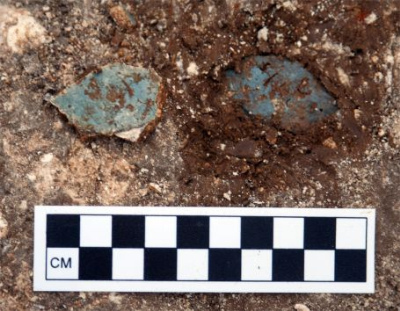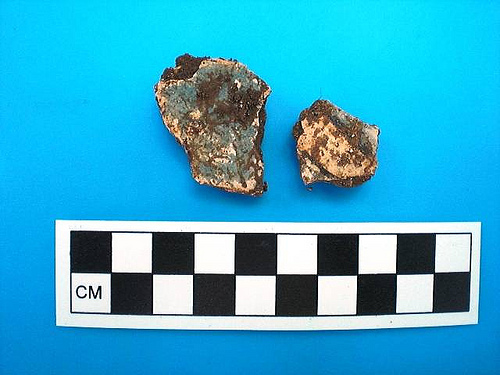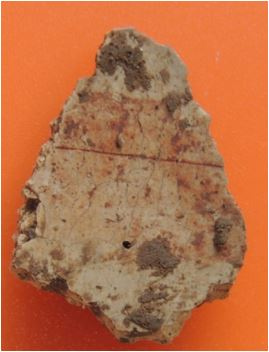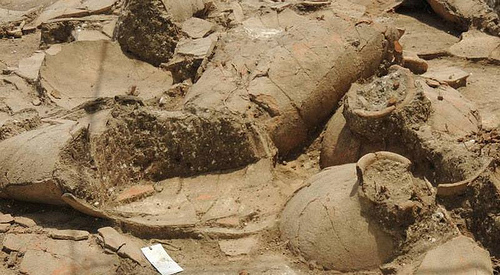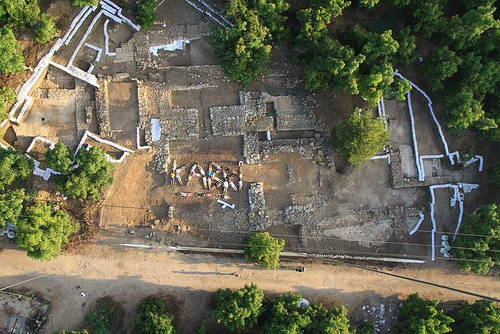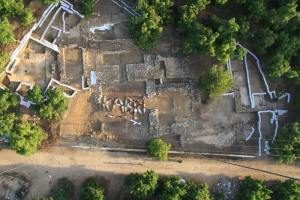
At first blush, there is nothing that stands out to any common visitor about the appearance of Tel Kabri, today an archaeological site that was once a thriving Canaanite center over 3,500 years ago. Located next to its namesake kibbutz in the western Galilee region of Israel, it is only one of a profusion of sites currently under excavation in this part of the Middle East. But ask the archaeologists and those who know something about the site, and you will get a different picture.
First, they might tell you that, unlike other ancient Canaanite sites, it is the only one that features remains from a Middle Bronze Age (the 2100 – 1500 BC time period) palatial complex largely undisturbed or obliterated by later construction from subsequent occupying cultures. This means that the palace discovered at the site (dated to the 18th century BCE), is also the only Canaanite palace of this period that can be fully excavated.
Second, it is the only Canaanite center that features remains from Minoan (or Aegean)-style wall frescoes and floor painting. Excavations conducted by [Aharon] Kempinski and [Wolf-Dietrich] Niemeier from 1986 to 1993 uncovered an Aegean-style painted plaster floor and numerous fragments that they suggested originally composed a miniature Aegean-style wall fresco. Only three other archaeological sites in the Middle East are known to have yielded Aegean-style frescoes and painting: Tell el-Dab’a in Egypt, Qatna in Syria and Alalakh in Turkey. The Tel Kabri fresoes and painting are, however, the only evidence of Minoan or Cycladic-style artwork in present-day Israel (or among the ancient Canaanites). And new excavations begun in 2005 under the direction of Eric Cline of George Washington University and Assaf Yasur-Landau of the University of Haifa have added to the discovery. During excavations in 2008 and 2009, they found more than 100 new fragments of wall and floor plaster, approximately 60 of which were painted and, according to their analysis, likely originally belonged to a second Aegean-style wall fresco with figural representations and a second Aegean-style painted floor.
_______________________________________________________________________________________________________________________
Above and below: Painted plaster fragments discovered during the excavations of 2008 and 2009. Courtesy Tel Kabri Excavation Project, Eric H. Cline, and Nurith Goshen.
_______________________________________________________________________________________________________________________
And now, their latest season of excavations, completed during the summer of 2013, has yielded more fragments of painted wall plaster. “Of these,” write Yasur-Landau and Cline, et al. in their preliminary report, “one has red paint and an incised string line; another awaits detailed analysis, but may have either a small bird or a fragment of vegetation.”* (See photo, right)
Incised string lines within painted plaster is known to be a distinctive characteristic of Minoan-style art. Says Cline, “the Minoans took a string and just tightened it so that it contacted the wet plaster and created a perfectly straight line. We have plaster at Kabri that shows that. The other thing they did was take string and dip it in, for example, red paint, and tighten it quickly against the plaster. The red paint thus makes a perfectly straight line…….That is a Minoan technique”.**
What was Minoan-style artwork doing at Kabri? Cline and his colleagues hope to one day have the answers as they continue to excavate the site. In any case, it is possibly the earliest-known Western style art found in the Eastern Mediterranean.
Equally, if not more significant, has been the recent discovery of a palatial multi-room storage complex containing nearly 40 large restorable Canaanite storage jars in a fully excavated room of the complex. The finds were made while they were digging an area adjacent to and west of a monumental building first excavated in 2011, a one-of-kind structure that was lined with precisely-shaped orthostat blocks. “This is the largest concentration to date of restorable pottery found anywhere in the palace of Kabri and the only place on site where we have found an entire room still full of artifacts,” writes Yasur-Landau and colleagues in their preliminary report. Moreover, they add that it is “the first time that such a storeroom with jars still present has been uncovered within an MB (Middle Bronze Age) palace in Canaan…….Samples for residue analysis were taken from almost all of the vessels; we are currently awaiting the results.”* The remains of six additional storage jars were found in an adjoining room just south of the room. This room has only been partially excavated and potentially may contain an additional concentration of restorable vessels. Analysis of the positioning of the jar remains in the rooms has led archaeologists to conclude that the jars were not used after they were last deposited, raising questions as to what led to their relatively sudden abandonment.
________________________________________________________________________________________________________________________
An amazing find: The remains of the restorable storage vessels, still in situ in the northern storage room, undisturbed and unused since they were last deposited or fell into place over 3,500 years ago. Courtesy Eric H. Cline and the Tel Kabri Excavation Project.
_________________________________________________________________________________________________________________________
The team also continued excavations within the palace, parts of which were exposed in previous seasons. The latest efforts revealed “an architectural continuum of ca. 75m in length within the palace”, including plaster floors and more fragments of restorable pottery.* Combined with what they already knew about the features and spatial layout of the palace, archaeologists are now concluding that “the projected extent of the palace may be between 5,000 and 6,000 square meters”.* The Tel Kabri structure is considered to be among the largest Canaanite palaces ever found.
Researchers are now looking forward to the results of LiDAR1 laser scans and the analysis of organic residue found in the pottery. Ultimately, the researchers hope the Tel Kabri excavations and research will offer what might be the most complete picture of palatial political, social and economic life in the Canaanite period, answering questions such as whether or not the Canaanites had a central government, whether taxes were levied, the type of agriculture practiced, and the trade networks operating during the time.
_______________________________________________________________________________________________________________________
Aerial view of the excavated area of Tel Kabri as it appears today. Note the excavators lying prone face-up on the ground, spelling out “Kabri”. Courtesy SkyView Photography, Ltd.
_______________________________________________________________________________________________________________________
But there is another mystery about this place.
“Kabri is like no other site I have ever investigated,” said Cline, “because it is so huge and because it was only occupied during the Middle Bronze Age [about 2100 – 1500 BC], with a puzzling absence of occupation and then suddenly an Iron Age [about 1200 – 500 BC] presence on the acropolis.”**
None of the causal factors that would explain this abandonment and long absence seem to be here, thus far. No clear signs of a massive fiery destruction from an invading army. No evidence of a natural disaster.
What happened here so long ago?
The answer may lie ahead — or not. In any case, as any seasoned archaeologist would likely say, there are often many other equally exciting surprises along the way.
______________________________
The excavation project, conducted every other year (the next will occur in the summer of 2015) invites participation by students and volunteers from all over the world. For more information about Tel Kabri, see the website. Readers can download the latest detailed preliminary report of the excavations here.
______________________________
* From the Preliminary Report on the Results of the 2013 Excavation Season at Tel Kabri, by Assaf Yasur-Landau, et al.
** From an interview with Eric Cline as published inThe Minoan Connection in the June 2011 issue of Popular Archaeology Magazine.
[1] LiDAR: (Laser Interferometry Detection and Ranging) — a remote sensing method that uses light in the form of a pulsed laser to measure ranges (variable distances) to the Earth. The data can be used to generate precise, three-dimensional information about a site and its features.
All images not otherwise posted are courtesy Eric H. Cline and the Tel Kabri Excavation Project.
________________________________________________________________________________________________________________________
Read about the most fascinating discoveries with a premium subscription to Popular Archaeology Magazine. Find out what Popular Archaeology Magazine is all about. AND MORE:
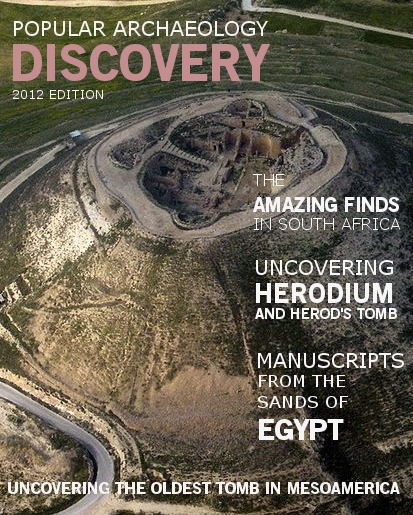 Popular Archaeology’s annual Discovery edition is a selection of the best stories published in Popular Archaeology Magazine in past issues, with an emphasis on some of the most significant, groundbreaking, or fascinating discoveries in the fields of archaeology and paleoanthropology and related fields. At least some of the articles have been updated or revised specifically for the Discovery edition. We can confidently say that there is no other single issue of an archaeology-related magazine, paper print or online, that contains as much major feature article content as this one. The latest issue, volume 2, has just been released. Go to the Discovery edition page for more information.
Popular Archaeology’s annual Discovery edition is a selection of the best stories published in Popular Archaeology Magazine in past issues, with an emphasis on some of the most significant, groundbreaking, or fascinating discoveries in the fields of archaeology and paleoanthropology and related fields. At least some of the articles have been updated or revised specifically for the Discovery edition. We can confidently say that there is no other single issue of an archaeology-related magazine, paper print or online, that contains as much major feature article content as this one. The latest issue, volume 2, has just been released. Go to the Discovery edition page for more information.
Subscription Price: A very affordable $5.75 for those who are not already premium subscribers of Popular Archaeology Magazine (It is FREE for premium subscribers to Popular Archaeology). Premium subscribers should email [email protected] and request the special coupon code. Or, for the e-Book version, it can be purchased for only $3.99 at Amazon.com.

